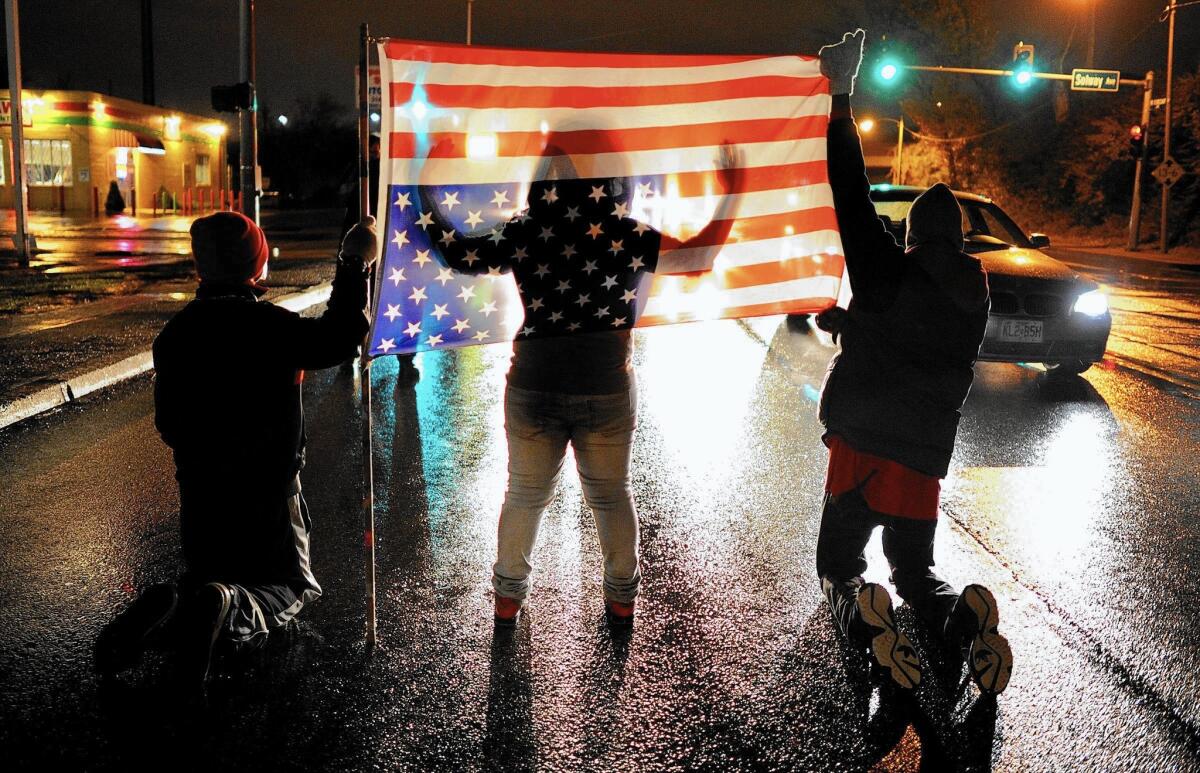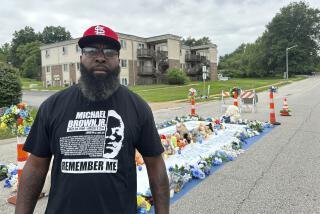Long history of racial tension set the stage for Ferguson protests

- Share via
Reporting From FERGUSON, Mo. — As Dorothy Kaiser rides down the main streets of Ferguson, the town unfolds before her like a diary. This neighborhood is newer; that one is older; she raised her children in this house, and grew up in that one herself.
As far as anyone can tell, she has lived here longer than anyone. She’s 80 now, and moved to Ferguson at 2. She understands this place.
Moving west along one of the town’s central streets, Suburban, she points and recounts and smiles. She knows every doorway and mailbox.
Then, at a narrow spot in the road, she falls silent. The diary slams shut.
“I wouldn’t really know this area,” she says.
This is where the gate used to be, she says.
The one to keep black people out.
::
At the narrow spot there’s a sign: “Welcome to City of Kinloch.”
In a few hours, a grand jury will announce its decision not to indict a Ferguson police officer who shot an unarmed black man, touching off protests around the nation, with a violent start outside the Ferguson Police Department. The grand jury, and observers around the globe, spent months examining the questions of what happened, and how. But it’s here, on Ferguson’s border with a forgotten community called Kinloch, where you can find the history that helps explain the explosive aftermath.
Kinloch is the oldest black town in Missouri, and possibly west of the Mississippi River, formed in the 1890s when a real estate developer found a loophole in laws against selling property to black people. Life there centered on Kinloch Airfield, a history-making place where President Theodore Roosevelt flew in a plane built by the Wright brothers, where the first control tower was built, where a man first parachuted out of a plane.
Larman Williams grew up in Kinloch. He is now 80, like his white counterpart, Dorothy Kaiser. Like her, he knew his town block by block, and remembers it as a vibrant place. “People were wonderful,” he said.
People were poor, sure, but they worked hard. The problem was that other than the airport, all the businesses — and so, the tax base — were based in Ferguson. Black people from Kinloch could cross into Ferguson during the day to work as maids or factory men. But they had to be back across the border by sunset, when the gates closed.
The ordinance ordering black people out of town was known as the “sundown law,” and cities across the nation had similar rules. Ferguson’s was around into the 1940s. And if whites and blacks had little contact or understanding of each other, that wasn’t surprising.
“Oh, I was scared of them,” Kaiser said. “They were black. They were different.”
The fear climbed in Ferguson, Kaiser said, when Missouri changed its laws against selling property to black people. “There was anxiety,” she said. “They were coming.”
And no gate could stop them.
::
By the late 1960s, Williams had finished school — a master’s degree in education — and taken a job as a teacher. He and his wife, Geraldine, decided to buy a home of their own.
“I wanted to live in a nice house,” he said recently, laughing. “I had bought us a big new car, and wanted a house to go with it.”
The house he saw on Buckeye Drive in Ferguson seemed ideal. Lots of windows, a big yard that sloped down to the street. A “for sale” sign.
“So I called,” he said. But the real estate agent could tell he was black, on the phone. No sale.
So Williams found a way around it, by calling his pastor, who went to speak to the seller on his behalf and vouched for his character, his work ethic, his spirituality. And it worked. In 1968, Larman Williams became the first black man in his neighborhood — and probably all of Ferguson — to buy property. His three children were the first black students to go to the Ferguson school.
“It was important, yes it was,” Geraldine said. She and Williams have since divorced and he lives in a home for seniors. But she still lives in the little house on Buckeye, where the day before Thanksgiving she and her grandchildren cooked in the kitchen.
Buying a house there felt important. But it didn’t feel good. Neighbors stood off from them, at first. Other kids wouldn’t befriend theirs.
Then one day, things started to change. “My neighbor called out to me from his yard,” Williams said. “He wanted to apologize. He had seen humanity in us, with time. People started to see us as part of the neighborhood.”
::
By the 1980s, everything in Ferguson changed.
The Kinloch Airfield, which had grown to become the St. Louis airport, needed land as it expanded. Lots of land. So it began buying up homes in Kinloch, scarfing up property at prices above the going rate — creating a pressure shift between Kinloch and Ferguson. Suddenly black people had enormous incentive to leave Kinloch and cross the border permanently.
“You had people with enough money to buy houses they couldn’t have afforded otherwise,” said former Ferguson Mayor Brian Fletcher. “Houses they couldn’t afford to maintain. So things went down.”
At first, black residents wound up clustered in neighborhoods where it was easier for them to buy property. Then, in relatively short order, they became the predominant demographic in Ferguson. In 1990, roughly three-quarters of residents were white, and one quarter was black. In 20 years that ratio reversed.
Kinloch imploded. Its population dwindled to just a couple of hundred people.
As Ferguson became more black, its political structure stayed white. The specifics would later be picked apart on cable news: A white mayor. An almost exclusively white City Council. Among scores of police officers, only a couple who were not white.
Fletcher said the city struggled during his term to find black police officers. Ferguson wanted them, he said, but they could make much better money in wealthier neighboring towns with lower crime rates. “They got the cream of the crop,” Fletcher said. “We just couldn’t make the ratios.”
Fletcher now runs the “I Love Ferguson” shop downtown, where he sat recently surrounded by Ferguson souvenirs. He spoke with enormous passion about his town.
Yes, there was a problem, he said. But no one knew how to solve it.
“I mean, yeah, there was tension,” he said. He shrugged and held his shoulders hunched. “But there’s always going to be tension. Right?”
::
The night the grand jury announced its decision not to indict Officer Darren Wilson for shooting Michael Brown, people gathered on the street in front of the Ferguson Police Department.
The crowd organized itself in identifiable concentric rings. On the edges there were people who came for the spectacle, laughing, jubilant. Toward the middle were people concerned but not violent; they had come to speak out. And at the middle, pressed against the barricades, was a core of people who spat at the police facing them.
“How can you live with yourself?” yelled 55-year-old Marvin Skull, who wore a ski mask and a bulletproof vest. He singled out the lone black officer in the line of police. “Hey, there’s some trash over here! Why don’t you come tidy it up for your masters?”
At the center of the protest someone used a bullhorn to castigate the police, in the minutes before the grand jury announced its findings. A few seconds after the announcement, the bullhorn arced through the air, end over end, and crashed into the police officers’ riot shields. The time for words had given way.
The rest of the night played out on front pages and television screens around the world, as looters plundered stores and some businesses went up in flames.
In his tiny room at the senior center, Larman Williams sat among the signifiers of his life: his Bible, his diploma, a photo of his parents, a photo of his children. He watched as the events unspooled on his television.
At first Williams understood the protesters and their wants. He had lived in this town — with this police force — longer than any of them. But once the violence started, he said, he felt nothing but heartbreak.
Many protesters were young — born decades after blacks had to leave Ferguson by nightfall. Many weren’t even from Ferguson — agitators who poured into town from other parts of Missouri or other states.
“It’s not the way we do this,” he said. “It’s so much foolishness.”
He searched a moment for his eyeglasses on a table, and finally looked up.
“I’m tired,” he said.
More to Read
Sign up for Essential California
The most important California stories and recommendations in your inbox every morning.
You may occasionally receive promotional content from the Los Angeles Times.










